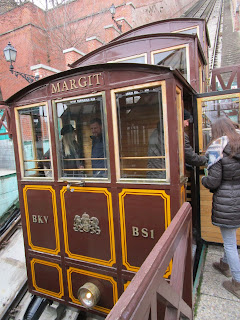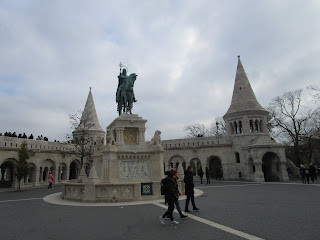 |
| Artsy picture from inside Fisherman's Bastion atop Castle Hill in Buda (and Budapest) |
It's the yellow line, Opera station, transfer to the red line to Batthyány tér. Exit.
And you see a nice church. You also see a nice church whichever direction you look when in Europe. Batthyány tér is, of course, no exception.
And you also the see the Parliament Building. Third time in Budapest and once again my plans to tour the Parliament building are thwarted. No tours today for some special event.
Then it's time to take the #19 tram.
All the way to Clark Adam tér (Adam Clark Square, Hungarian being an Asian culture transported and dropped into Central Europe, the name convention has the family name first. (Gabor Zsa Zsa, por ejemplo.) And then we are there.
Along with a large number of tourists.
But who doesn't love to take the funicular!
It's fun! Fun for the whole family!
And after a few extremely fast-moving minutes on the slow train up a mountainside, we arrive at our destination.
Castle Hill. This is tourist Budapest. This is where you get accosted by guides selling their services in a variety of languages. (Italian seemed to be particularly popular today, surprisingly. English is always in fashion. French, too. German did not seem to representing today, for some reason.)
This is a view of the Chain Bridge, or the Széchenyi Lánchíd. This is the Turul Bird.
It's symbolic. Real birds don't fly around with swords in the beaks.
This next building is guarded by military-looking gentleman.
I think it used to be something rather it is something, but don't know don't care. Actually, I do care. But I gave up when I couldn't get an answer in two google searches. I think it's just a generic government building now, albeit one with a cool locale.
This is the Honvéd-szobor. Really. English please. It's the Statue of the Independence War.
Then there's the Holy Trinity Statue:
And then there's Mátyás Templom, the Matthias Temple.
It's right next to Fisherman's Bastion, the turrets of which are a signature view from the Pest side of the Duna.
It may be a Friday in late November, but the tourists are out.
This is the Szent István szobra, the St. Stephen statue.
At this point, I'm looking for the ticket booth to get into Mátyás Templom. Having taken two metro lines, a tram, and a funicular to get here, I want to get in.
Well, the ticket booth appears not to be hidden in the Fisherman's Bastion, which would've been a stupid place to put the ticket booth, seeing as it's already crowded.
So I can see Mátyás Templom, but where's the ticket booth.
But first, let's take a break from the quest for the ticket booth to take another artsy shot using Fisherman's Bastion to frame shots of Pest.
Spoiler alert: I eventually found the ticket booth. It was opposite the entrance on the other side of St. St. Stephen the Statue. It was photogenic so I didn't take a picture. The interior of Mátyás Templom, on the other hand, was quite photogenic:
Apparently at the noon hour or so that I was there (hey, I got a late start today, I'm on frickin' vacation you know), there was a concert by a children's choir.
The place was packed with tourists and parents, the only two groups of people known to absolutely love love love children's choirs in historic church buildings.
No snark intended, however, as the children were very good. And they sang four or five songs, which was the perfect length for a lunchtime children's chorale for tourists in late November in a historic church building. One of those four-hour Springsteen style never-enders most certainly would not have been appropriate.
These are from a chapel off to the side.
Back into the daylight. Well, it's more gloom-light. And here is Pope Innocent XI, as statuary.
Streets of Castle Hill, looking back toward Mátyás Templom.
This was a really cool limo. It did not date back to the 1800's when Castle Hill housed actual Hungarian kings. In a castle. But it too was a relic of a bygone, never to return, time.
I pass by the Vienna Gate, the historic exit for Castle Hill.
But I'm not exiting just yet.
I pass by the ruins of the Mary Magdalene Church.
The tower is all that was left standing after WWII bombing.
You can see the outline of the old church walls. This is a super-gigantic bronze replica of the collar worn by, if I recall correctly, monarchs being coronated.
I could just be making that up, but that wasn't my intent.
The church is gone.
But Kapisztran is still there, at Kapisztran Square. This is a statue of Svent Janos Kapisztran, the Soldier Saint.
In Orange County, California, they know the Soldier-Saint Svent Janos Kapisztran as San Juan Capistrano. Fitting that his statue would be outside Hadtörténelmi Levéltár Budapest, the Hungarian military museum.
It's the 100th anniversary of the museum so, in celebration, they are charging 100 HUF, Hungarian forint, to get in. Is that a lot or is that a little? Given the current exchange rate, that's about 30 cents U.S. So, woo-hoo. Bargain.
Lots of mannequins as soldiers. In fact, given the large number of mannequins who served as troops, it is perhaps unsurprising the bad run of war-losing experienced by the Hungarian military in the 20th Century.
After the war, the mannequin soldiers who survived got jobs as department store models.
The mannequin soldiers rode horses.
And they rode motorcycles too. Actually, there was a lot more to the museum than mannequins in military uniforms. A lot more. And much of it was very interesting, particularly the maps and the segment about Hungary's WWII soldiers being taken prisoners and sent to the Soviet Gulags and other forced labor camps. Not good. But for some reason I only ended up taking pictures of the mannequin soldiers. So there.
Once out of the museum and back in Pest, I could take pictures of statuary, including inappropriately dressed for the sub-freezing temperatures statuary. (And by "sub-freezing" I mean one or two Fahrenheit degrees below the freezing point.)
Let's end with wooden statutes at the Budapest Christmas market. I'd want one, but they wouldn't fit into my checking baggage.











































No comments:
Post a Comment